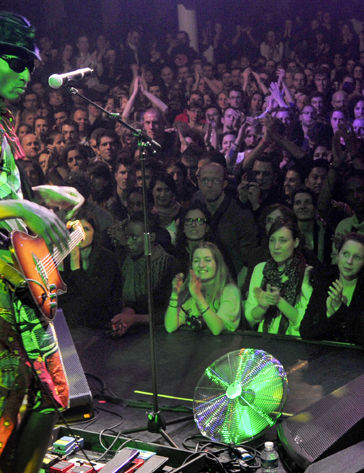Say what you want about Paris (I often do), but what it does have in abundance is character and history; a fine example of these qualities emanates powerfully from the four walls that house the city's most esteemed music venue, the Bataclan, which has been entertaining punters since the late 19th Century. Headliner popped inside to check out Nigerian-born Keziah Jones' guitar-slapping 'blufunk' that's been gripping capacity crowds across the globe...
Keziah Jones moved from Lagos to London when only eight- years-old, and has lived in the UK ever since. He got his first break whilst busking in London's Portobello Road in 1991 after being spotted by Culture Club's keyboard player (who penned Karma Chameleon), Phil Pickett. Rather charmingly, Pickett's son, Harry, is now Jones' tour manager. This artist uses a plethora of [US-manufactured] Lag Signature guitars, and it takes five channels to generate the right tone from various DIs and mics that capture the sound from his two Vox cabinets (one muddy, one clean), as well as his cool percussive style.
Because all of the low mid from stage is coming from the guitar cabinets, it's a very loud stage, and FOH engineer, Darren Connor chooses not to fire any of it through the house system. He's also very busy riding the vocal fader.
“I use an Avalon 737 on Keziah's vocal and do some parallel compressing: I send it to a stereo group, then send a mono signal to the PA, which is then compressed using the 737; and I've then got a stereo group which is also compressed, and I send that to a stereo bus,” he explains. I try to process the information, then thankfully he summarises. “Basically, I end up with three channels of vocals, one heavily compressed and a grouped stereo pair.”
Connor then adds colour to the vocal using “a smooth plate reverb from the house rack”. He'd normally bring his own rack, he tells me, but for this trip he was flying RyanAir... Enough said.
Jones' monitor engineer, Daniel Paine, actually started out as his guitar tech. He cites that as a great foundation for any monitor engineer, as he believes it helps build a trust with the artist.
“It definitely gives me an edge, and for Keziah in particular, as his tone is so unique,” he explains. “I studied music technology and audio systems design at the University of Derby [UK] as I wanted to find out more about mixing and the tech behind it; but as a musician, I can see it from a perspective of the guitarist. For example, if someone shouts to turn up the wedge, I am aware that sometimes it isn't necessarily volume they need; it helps when you understand the guitar tone.”
Jones' monitoring setup centres around Nexo's 45N-12. He uses four of them: two per side configured in an inner and outer configuration. A pair of Nexo PS15-R2s are also used as stage sidefills.
“It's mainly vocal and guitar through the wedges, and it's extremely loud - one of the loudest mixes on stage for monitoring that I've ever come across, which was partly the reason for going with the N-12s; they have mountains of headroom,” Paine reveals. “We've been experimenting on this tour, and currently we are using a harmoniser on his vocal, which makes it more spatial rather than attacking; Keziah's guitar sound is actually louder out of the wedges than his backline sound in some situations, so it's very important to get the tone correct.
“What we've been able to achieve using the N-12s is the equivalent of tilting his Vox amps in front of him, because the wedge is flat enough sounding for me to do whatever I want with it, therefore we can replicate not only the tone, but the volume too; I've got a lot of bottom end in there, yet I've also got the cut from the vocal without it sounding too harsh. It's gobsmacking how stable the N-12 is at high volume; it's the least volatile wedge I've come across.”

